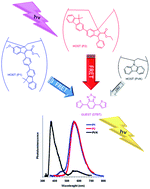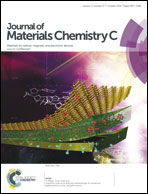Highly emissive supramolecular assemblies based on π-stacked polybenzofulvene hosts and a benzothiadiazole guest†
Abstract
Two new benzofulvene derivatives bearing a fluorene chromophore in different positions of the phenylindene scaffold were synthesized and induced to polymerize spontaneously. The photophysical investigation evidenced the role of the substitution topology of the monomeric units in the optical properties of the corresponding polymers. In particular, the polymer emission efficiency was found to improve both in solution and in the solid state when the fluorene residue enhances monomer conjugation and rigidity. The ability of this newly synthesized class of polymers to self-organize in supramolecular structures is evidenced through a study on blends with a benzothiadiazole based dye at different concentrations. Aggregation quenching processes of the dye are sharply reduced and complete resonant energy transfer from the polymer to the dye is reached even at 1% dye concentration. The peculiar ability of this new class of π-stacked polymers to self-assemble in such a supramolecular organization suggests their use as platforms for the design of more complex nanostructured films with enhanced optical and optoelectronic properties.


 Please wait while we load your content...
Please wait while we load your content...